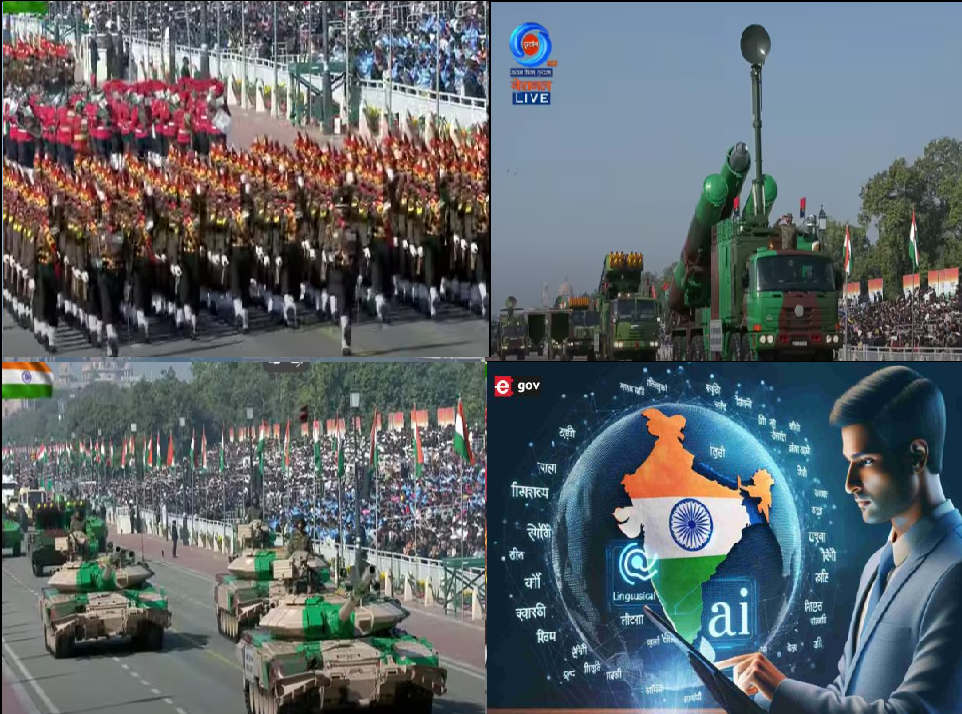
- The budget, which is 9.5% higher than last year at ₹6.81 lakh crore ($79 billion), signifies India’s priority on operational preparedness, improving its military modernity status, and self-reliance in defence technology.
- Seventy-five per cent of the capital expenditures go directly to Indian enterprises as part of the Made in India initiative for Indigenous procurement and capital expenditure.
- With nearly ₹10,300 crore allotted to the India AI Mission in prior years, the Union Budget 2025–2026 places a significant emphasis on Digital & AI Diplomacy, demonstrating a determined effort to become a worldwide leader in artificial intelligence.
- Combining infrastructure, diplomacy, energy, and defence within one all-embracing strategy, India emerges as a strong, independent, and resilient nation on the world stage.
Budgeting for Tomorrow India’s 2025 Allocations in Defence Trade and Technology
Increasing commitment to building strong military capabilities and better geopolitical positioning for India lies in its defence expenditure for the fiscal year 2025–2026. The budget, which is 9.5% higher than last year at ₹6.81 lakh crore ($79 billion), signifies India’s priority on operational preparedness, improving its military modernity status, and self-reliance in defence technology. With a budget of 1.9% of the nation’s GDP and 13.5% of all government spending, this is among the most important steps in enhancing India’s defence capabilities in the face of rising threats from Pakistan and China, India’s neighbours. This article reviews the main elements, strategic significance, and budgetary allotments of India’s 2025–2026 defence budget, which also provides insights into how these expenditures fit with the nation’s long-term security and diplomatic goals.
Important Allocations:
- Capital Spending (₹1.8 lakh crore/$20.8 billion): This will be used to purchase high-end weapons, including aircraft, ships, and other defence apparatus, to counter possible threats from China and Pakistan.
- Revenue spending (₹3.11 lakh crore, or $35.6 billion) comprises costs for supply chains, wages, and servicemen’s military training in order to ensure uninterrupted operations.
- Spending on pension defense (₹1.6 lakh crore, or $18.4 billion): aids in providing ex-service members and their dependents with financial stability. The degree of confidence also helps.
- For increased independence and inventiveness, a research and development budget of ₹26,816 crore (about $3.3 billion) will be allocated to space technology, robots, artificial intelligence, and cyberwarfare.
- Seventy-five per cent of the capital expenditures go directly to Indian enterprises as part of the Made in India initiative for indigenous procurement and capital expenditure.
- The primary investments are ₹48,614 crore ($5.6 billion) for aircraft and engines.
- Naval expansion: $2.80 billion (₹24,390 crore)
- Land Systems & Heavy Vehicles: ₹3,651 crore ($440 million)
- Arunachal Pradesh and Ladakh’s border infrastructure is being strategically upgraded.
Strategic Importance
India’s increased defence budget will improve its military readiness, lessen its reliance on foreign technology, and increase the deterrence effect. Modernization and indigenization will remain India’s long-term security objectives since the nation is prepared to handle the new difficulties posed by the changing geopolitical landscape and will dissuade any possible threats from China and Pakistan.
Foreign Trade and Economic Diplomacy: Budget 2025-26
International Trade and Economic Diplomacy Budget for 2025–2026 – The Union Budget 2025–2026 has allotted ₹20,516 crore to the Ministry of External Affairs and an additional ₹6,750 crore for special economic diplomacy initiatives. This demonstrates India’s strategic emphasis on increasing trade ties, infrastructure projects, and diplomatic clout in important fields.
To prevent China’s Belt and Road Initiative and to promote regional stability, India’s political geography employs economic diplomacy. As a result, Indian businesses abroad enjoy more connectivity, enhanced trade, and more stable economies. The “Neighbourhood First” and “Act East” agendas, improve soft power diplomacy, energy collaborations, and regional trade.
As the Maldives and Sri Lanka receive aid for infrastructure, defence, and economic recovery, China’s influence is challenged. Bangladesh places a higher priority on connectivity and trade than Myanmar does on humanitarian and economic aid. Africa and Latin America benefit from increased commerce, investment, and infrastructure.
Allocations for Infrastructure, Energy Security and foreign aid
To increase India’s economic and geopolitical might, the Union Budget 2025-26 prioritizes foreign aid, energy security, nuclear energy, and infrastructure. Infrastructure has been allotted ₹11.1 lakh crore, a 15% increase over the previous year. ₹2.7 lakh crore for PM Gati Shakti, ₹1.5 lakh crore for Bharatmala Phase II, and ₹10,000 crore for North-East Infrastructure Development are among the major projects. It is noteworthy that ₹4,000 crore would be allocated to the INSTC and Chabahar Port in order to improve India’s trade connectivity with Central Asia.
With a focus on renewable energy, ₹1.97 lakh crore has been set aside for energy security. The strategic oil reserves will be protected with ₹10,000 crore, and solar, wind, and green hydrogen will be supported with ₹45,000 crore. Furthermore, the International Solar Alliance (ISA) would receive ₹5,000 crore.
₹20,000 crore will go towards nuclear energy, of which ₹12,000 crore will go toward increasing nuclear capacity and ₹8,000 crore will go toward Small Modular Reactors (SMRs). Foreign aid from India has increased to ₹5,483 crore, helping nations like Maldives, Nepal, Sri Lanka, and Bhutan. These investments highlight India’s expanding contribution to global trade and sustainable energy.
Digital & AI Diplomacy
With nearly ₹10,300 crore allotted to the India AI Mission in prior years, the Union Budget 2025–2026 places a significant emphasis on Digital & AI Diplomacy, demonstrating a determined effort to become a worldwide leader in artificial intelligence. By integrating AI into healthcare, education, and government, this investment will improve public service delivery, increase India’s competitiveness internationally, and grow the country’s digital economy. The United States, Germany, Japan, and EU countries are the primary recipients of AI partnerships.
The budget continues to prioritize cultural diplomacy on Diaspora and Soft Power Diplomacy, although specific numbers were not provided. Involving the Indian diaspora around the world is essential for advancing cultural interaction, boosting economic growth, and enhancing India’s soft power. Programs for Overseas Indians are endeavours that promote investment flows, knowledge sharing, and involvement in India’s development. Countries with sizable Indian populations, such as the United States, Canada, the United Kingdom, and Australia, would be major beneficiaries. Along with building economic and cultural connections around the globe, these initiatives also strengthen India’s diplomatic influence and raise its standing internationally.
Conclusion
In 2025–2026, India has reserved a strategic budget for international aid and defence. It is marching towards independence, military modernization, and growth in global trade and diplomatic ties. If defense investment significantly increases, India will be militarily better prepared, less dependent on foreign technologies, and better able to manage emerging geopolitical threats from China and Pakistan. In this way, India’s defense infrastructure and technology will benefit from the money allocated to capital expenditure, revenue spending, and research and development if the country has a robust, independent defense sector.
The concurrent efforts of economic diplomacy and foreign aid by India reveal its international reach. Nuclear energy, energy security, and infrastructure investments would solidify strategic relationships with other leading countries in South Asia, Africa, and Latin America and help the nation prosper. India is proving it wants to be at the forefront of technology and improve its prospects of competing internationally by embracing digital and AI diplomacy.
Combining infrastructure, diplomacy, energy, and defence within one all-embracing strategy, India emerges as a strong, independent, and resilient nation on the world stage. Thus, it’s assuming a position to face future difficulties and establish itself at the forefront among significant players in the world scene by emphasizing modernization, innovation, and international cooperation.
References:
- https://pib.gov.in/PressReleasePage.aspx?PRID=2098912
- https://pib.gov.in/PressReleasePage.aspx?PRID=2098485#:~:text=In%20pursuance%20of%20Prime%20Minister,Ministry%20of%20Defence%20(MoD).
- https://pib.gov.in/PressReleseDetailm.aspx?PRID=2098380®=3&lang=1
- https://pib.gov.in/PressReleseDetailm.aspx?PRID=2098394®=3&lang=1
- https://aliceblueonline.com/stock-market-news/union-budget-2025-govt-allocates-rs-6-lakh-cr-for-defence-sector/
- https://www.janes.com/osint-insights/defence-news/industry/india-announces-95-increase-in-202526-defence-budget
- https://www.financialexpress.com/business/indias-defence-budget-in-the-shadow-of-giants-how-it-stacks-up-against-china-and-the-us-3735052/
- https://www.niti.gov.in/sites/default/files/2023-03/National-Strategy-for-Artificial-Intelligence.pdf
Piyush Anand is a Biotechnology Engineering student at Chandigarh University. His primary interest lies in International Affairs, Defence and Strategy. Views expressed are the author’s own.
